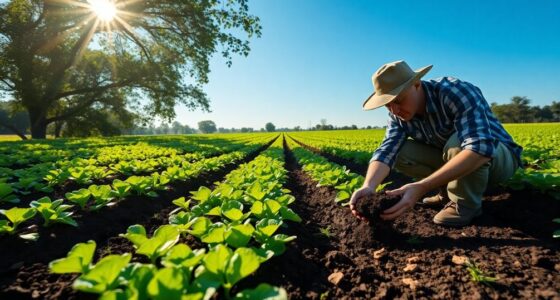Pollinators like bees, butterflies, and bats are vital for our ecosystems and food supply, yet they face a growing array of threats. From habitat loss to pesticide exposure, their populations are declining at an alarming rate. Understanding what’s causing this crisis is crucial if we want to protect these essential creatures. The challenges they face are complex, and the solutions require awareness and action—so, what can we do to make a difference?
The Importance of Pollinators in Ecosystems and Agriculture
Pollinators play a vital role in maintaining healthy ecosystems and supporting agriculture. Without them, many plants wouldn’t reproduce, which affects the entire food chain. You rely on pollinators like bees, butterflies, and bats to fertilize flowering plants, ensuring fruits, vegetables, and nuts develop properly. Their work boosts crop yields and maintains biodiversity, helping ecosystems stay resilient. When pollinators visit flowers, they transfer pollen, enabling plants to produce seeds and fruit. This process sustains wildlife, from insects to large mammals, and supplies food for human consumption. Additionally, research indicates that sound vibrations can influence cellular regeneration and overall health, highlighting the intricate connections within natural systems. You mightn’t see their work directly, but it’s essential for the food you eat and the natural environments you enjoy. Protecting pollinators is crucial for a healthy planet and a secure food future.
Major Threats Facing Pollinator Populations
Despite their vital role in supporting ecosystems and agriculture, pollinator populations face numerous threats that jeopardize their survival. Pesticides, especially neonicotinoids, harm pollinators by impairing their navigation, feeding, and reproduction.
Habitat loss from farming practices, urban development, and monocultures reduces the availability of diverse floral resources. Climate change disrupts pollinators’ life cycles and alters blooming patterns, making food sources scarce or mistimed.
Diseases like colony collapse disorder and parasitic mites weaken bee colonies, while invasive species compete for resources and introduce new pathogens. Additionally, pollution contaminates pollen and nectar, further stressing pollinator health.
These combined threats create a precarious situation, making immediate action essential to prevent irreversible declines in pollinator populations. YouGoNews continues to highlight the importance of protecting these crucial species for ecological balance.
The Impact of Habitat Destruction and Urbanization
Habitat destruction and urbanization have rapidly transformed the landscapes pollinators rely on, leaving them with fewer places to forage, nest, and reproduce. As natural habitats shrink or become fragmented, pollinators struggle to find enough food sources like flowers and nectar. Vetted portable camping gear options include shelters and outdoor equipment that can be used to create temporary green spaces and nesting sites in urban environments. Urban areas often replace green spaces with concrete and buildings, reducing available habitat. You might notice fewer flowering plants in your neighborhood, which directly impacts pollinator populations. Without safe nesting sites, bees and bats have nowhere to lay eggs or raise young. This loss of habitat forces pollinators to travel farther, increasing their energy expenditure and exposure to dangers.
Pesticides and Chemicals: A Double-Edged Sword
Pesticides and chemicals are powerful tools for controlling pests, but they often become a double-edged sword for pollinators. When you apply these substances, they can unintentionally harm bees, butterflies, and bats, disrupting their ability to forage and reproduce.
Certain chemicals, like neonicotinoids, persist in the environment, accumulating in pollen and nectar. As pollinators visit treated plants, they absorb toxins that impair their navigation, weaken their immune systems, and reduce their lifespan.
While pesticides protect crops, their widespread use creates a dangerous ripple effect in ecosystems. You might think you’re safeguarding your harvest, but you’re also risking the decline of vital pollinator populations.
Balancing pest control with pollinator safety is crucial to reversing the pollinator crisis. Additionally, chemical persistence in the environment can prolong the impact of these toxins, making it even harder for pollinator populations to recover.
Climate Change and Its Effects on Pollinator Behavior
Have you noticed how unpredictable weather patterns are becoming? Climate change disrupts pollinator behavior by altering flowering times and nectar availability. When temperatures rise unexpectedly, plants bloom earlier or later than usual, confusing pollinators that rely on consistent cues. A lack of suitable support solutions can further compromise their ability to adapt to these changes. Bats, bees, and butterflies may struggle to find food, leading to reduced reproductive success. Extreme weather events, like storms or droughts, further threaten their habitats and foraging habits. As climate change speeds up, pollinators might change migration patterns or shift habitats, which can cause mismatches between pollinators and plants. This disruption not only harms pollinator populations but also jeopardizes the plants and crops that depend on them. Your understanding of these changes highlights the urgent need to address climate impacts on pollinator behavior.
Strategies and Initiatives to Protect Pollinator Species
What can be done to protect pollinator species from ongoing threats? You can support and create pollinator-friendly habitats by planting native flowers, avoiding pesticides, and maintaining wild areas. Participating in local conservation programs helps restore bee and butterfly populations. Additionally, designing your garden with space and organization in mind can provide better environments for pollinators to thrive. Governments and organizations are implementing initiatives like establishing protected areas, funding research, and promoting sustainable farming practices. Public awareness campaigns educate communities about pollinator importance and how to assist their survival. Supporting policies that reduce pesticide use and encourage organic farming makes a significant difference. Additionally, citizen science projects allow you to monitor pollinator health and contribute valuable data.
Conclusion
If you want to help save pollinators, start by supporting sustainable farming and planting pollinator-friendly gardens. Reduce your use of harmful chemicals and advocate for habitat conservation. Every action counts in creating a healthier environment for bees, butterflies, and bats. By raising awareness and making mindful choices, you play a vital role in protecting these essential creatures and ensuring a thriving ecosystem for future generations.








